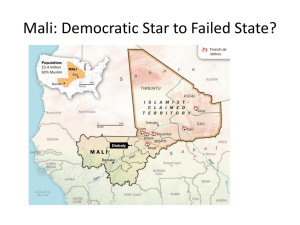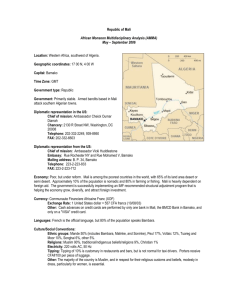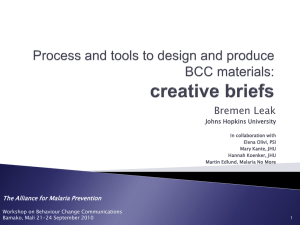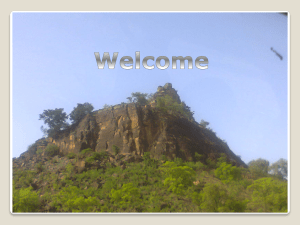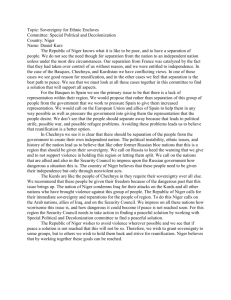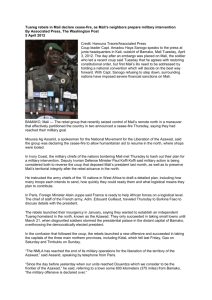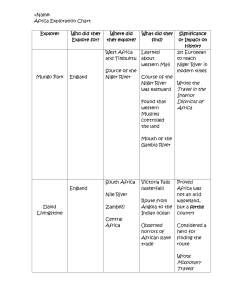msword
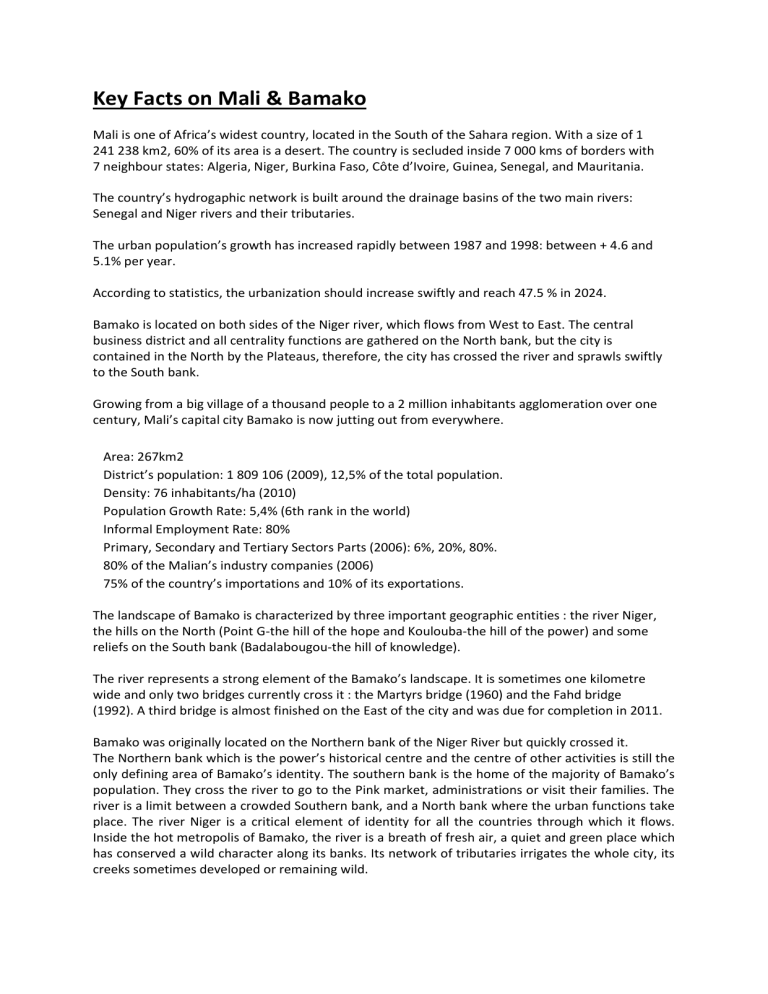
Key Facts on Mali & Bamako
Mali is one of Africa’s widest country, located in the South of the Sahara region. With a size of 1
241 238 km2, 60% of its area is a desert. The country is secluded inside 7 000 kms of borders with
7 neighbour states: Algeria, Niger, Burkina Faso, Côte d’Ivoire, Guinea, Senegal, and Mauritania.
The country’s hydrogaphic network is built around the drainage basins of the two main rivers:
Senegal and Niger rivers and their tributaries.
The urban population’s growth has increased rapidly between 1987 and 1998: between + 4.6 and
5.1% per year.
According to statistics, the urbanization should increase swiftly and reach 47.5 % in 2024.
Bamako is located on both sides of the Niger river, which flows from West to East. The central business district and all centrality functions are gathered on the North bank, but the city is contained in the North by the Plateaus, therefore, the city has crossed the river and sprawls swiftly to the South bank.
Growing from a big village of a thousand people to a 2 million inhabitants agglomeration over one century, Mali’s capital city Bamako is now jutting out from everywhere.
Area: 267km2
District’s population: 1 809 106 (2009), 12,5% of the total population.
Density: 76 inhabitants/ha (2010)
Population Growth Rate: 5,4% (6th rank in the world)
Informal Employment Rate: 80%
Primary, Secondary and Tertiary Sectors Parts (2006): 6%, 20%, 80%.
80% of the Malian’s industry companies (2006)
75% of the country’s importations and 10% of its exportations.
The landscape of Bamako is characterized by three important geographic entities : the river Niger, the hills on the North (Point G-the hill of the hope and Koulouba-the hill of the power) and some reliefs on the South bank (Badalabougou-the hill of knowledge).
The river represents a strong element of the Bamako’s landscape. It is sometimes one kilometre wide and only two bridges currently cross it : the Martyrs bridge (1960) and the Fahd bridge
(1992). A third bridge is almost finished on the East of the city and was due for completion in 2011.
Bamako was originally located on the Northern bank of the Niger River but quickly crossed it.
The Northern bank which is the power’s historical centre and the centre of other activities is still the only defining area of Bamako’s identity. The southern bank is the home of the majority of Bamako’s population. They cross the river to go to the Pink market, administrations or visit their families. The river is a limit between a crowded Southern bank, and a North bank where the urban functions take place. The river Niger is a critical element of identity for all the countries through which it flows.
Inside the hot metropolis of Bamako, the river is a breath of fresh air, a quiet and green place which has conserved a wild character along its banks. Its network of tributaries irrigates the whole city, its creeks sometimes developed or remaining wild.
The Niger is used by some of Bamako’s people for fishing, for transportation with pirogues, market gardening, washing, sand extraction, etc.
A city related to the colonial history
Bamako, national and economic capital of Mali is a young urban territory. Its urban history began in the end of the XIXth century, with the arrival of the French colons who settled upon the site, which at first was just a small village with few inhabitants, like so many others at that time, along the Niger river. The development of the city is moderate and gradual until the dawn of the independence, the
22 nd September 1960: 29 000 inhabitants in 1933, 37 000 in 1945, 130 000 in 1960, 660 000 in 1987.
1960 : Crossing the Niger river, the excessive growth of the contemporary city.
Bamako, which was contained in the North bank, crosses the river in 1960 with the opening of a first bridge (The Martyrs Bridge), and a second one in 1992 (The King Fahd Bridge). Gateways to new expanding territories, these South banks entrances promote the city's development in the South, and it becomes exponential from the early 70's, with the addition of a massive rural depopulation and a very important birth rate (now about 6.6 children/women). The city grew continuously since and, the lack of natural borders in the South, makes it spread indefinitely. In 1998, the number of inhabitants in Bamako reaches one million and, two millions in 2010.
Bamako today and tomorrow: An urban metropole with an increasing attractiveness and dynamism.
With a 5.4% annual urban growth rate, the highest in Africa (6th rank in the world), Bamako will count 3 million inhabitants by 2020. If only 12% of the Malian population live nowadays in Bamako, analysts foresee that in 2050, more than half the Malian population will be urban, and the majority of them will live in Bamako. This creates a major issue to be managed.
View source presentation at http://www.ateliers.org/en/sites/default/files/docschantiers/Topic_Atelier_Bamako_EN.pdf
Urban growth of Bamako Source : Sébastien Philippe, Une histoire de Bamako
North / South dichotomy
Two different conceptions of « making the city » between the North bank and the South bank.
The two banks of the Niger River are not tied to the same urban history. The Northern bank is firmly rooted in the colonial city's history (from the end of the XIXth century to the middle of the XXth century), whereas the Southern bank developed itself after the independence: it's the expression of the postcolonial history and, more precisely, Bamako's contemporary history. These two time periods epitomize two different urban development modes.
The Northern bank's colonial city is planned in a rational way leaning on an urban structure that was thoroughly designed and methodically realized: traffic network, islets, public areas, city centre, infrastructure (railways and rail station, public amenities). It has been founded upon a European based urban culture. It hosts most of the jobs and economic resources, both mainly tertiary, and especially commercial (unofficial) activities that are gathered around the Pink Market. The public amenities, the financial institutions and the major infrastructures (hospitals, schools) are also found there ; there is also an industrial activity park (a project is currently planned to take place in the
Southern Bank) and most of the urban recreational activities (cultural centres, restaurants, art galleries) along the Koulikoro, located outside the city centre and the Pink Market.
The Southern Bank's contemporary city has a less organized development, despite a structured urban network. Because of the swift urban growth, and because the resources are insufficient to properly manage these new urban areas, planning always seems to try and catch the development train. Thus, the Southern bank's life organization is first thought through a sector-based catching up strategy (oriented by the financial backers) with no real development frame and no wide forecasting urban vision (multi-sector).
As new populations tend to settle there, it is now Bamako's bedroom community and the home for more than 50% of the population. Yet this bank is not strictly lacking polarities (markets, stations, infrastructure, business, services, public amenities) but they are spread across this wide territory and therefore are not structuring elements and can't really be considered as an efficient alternative offer to the Northern bank's attractiveness, i.e the commercial attractiveness of the Pink Market.
This bicephalous situation where the structured city and the job areas can be found on one side of the river and the spontaneity and housing areas on the other, creates commuting situations, mainly from North to South, that are difficult because of the Niger River's crossing that is only possible thanks to the three bridges. The Southern bank seems to be not quite a city, but more a wide suburban extension. The Niger River, which magnificently crosses the city, remains a strong natural barrier between the city's two banks.


